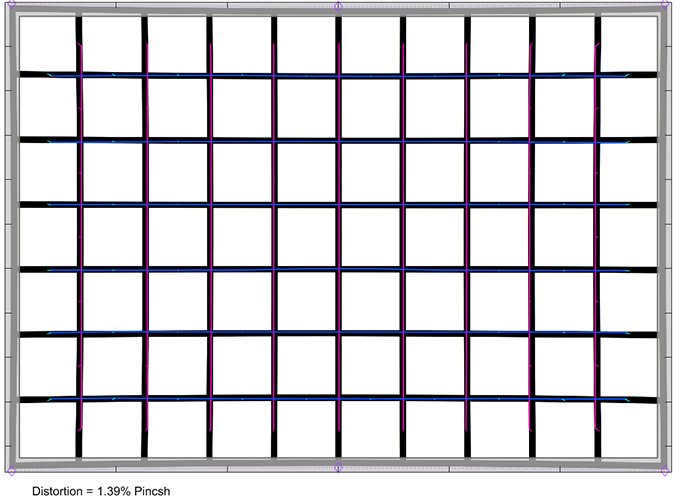|
Tokina atx-m 56mm f/1.4 X - Review / Lens Test Report - Analysis |
|
Lens Reviews -
Fujifilm X
|
|
Page 2 of 3

Distortion
As mentioned, the Tokina lens doesn't include a built-in correction profile thus you have to live with the raw optical performance. Eventually, you may see a correction profile in your favorite RAW converter but that's not guaranteed, of course.
The lens produces a medium pincushion of ~1.4%. While not ideal, this remains within acceptable limits for most applications.

Vignetting
The vignetting characteristic of the Tokina atx-m 56mm f/1.4 is a bit on the weird side. At f/1.4, the (raw-)light falloff is very moderate at just ~0.6EV (f-stops). Usually, this doesn't require additional correction. Stopping down to f/2 reduces this to 0.4EV. Strangely f/2.8 doesn't change much whereas the light falling is dropping a little at f/4 again. Our best guess is that there's either something going on under the hood or the vignetting distribution changes in a way that confuses our tool (Imatest). Regardlessly, there isn't really much to worry about anyway.

MTF (resolution)
The Tokina lens provides a solid performance on a 26-megapixel sensor albeit it's not flawless. At f/1.4 the broader center performance is very high with a slightly reduced contrast. The border quality is weak although that's probably not a show-stopper in this lens class. Stopping down to f/2 lifts the dead center to excellent levels. The center reaches its peak performance at f/2.8. The quality of the outer image field increases gradually with decent results at f/2.8 and very sharp quality around f/5.6. Diffraction effects are getting obvious at f/11.
The field curvature is marginal. The centering quality of the tested sample was good.
Please note that the MTF results are not directly comparable across the different systems!
Below is a simplified summary of the formal findings. The chart shows line widths
per picture height (LW/PH) which can be taken as a measure for sharpness.
If you want to know more about the MTF50 figures you may check out the corresponding
Imatest Explanations

Chromatic Aberrations (CAs)
Lateral CA (color shadows at the image borders) are well controlled with an average pixel width peaking at 1.3px mark at the image borders at f/1.4. The CAs decrease when stopping down with the best results at f/5.6 and f/8. Overall this is a good result.

Purple Fringing
Tokina has an old enemy - purple fringing (PF). PF is a blooming effect at harsh contrast transitions. As you can see below, the issue isn't unknown to the 56mm f/1.4 as well. PF can be corrected (as shown to the right below) but it's usually a manual effort in post and not 100% perfect. Keep in mind that this is a rare effect and it's primarily limited to large aperture shots.

Bokeh
While sheer sharpness is certainly an important criterion, you rarely buy an ultra-fast lens for it alone. The primary application tends to be shallow depth-of-field photography and the quality of the bokeh should be a priority in your purchasing decision as well. So how does the Tokina lens perform in this respect?
Out-of-focus highlights are beautifully rendered in the image center with no outlining and a very smooth inner zone. A more edgy aperture shape is already visible at f/2 and it's getting more obvious from f/2.8 onward.
 The images below illustrate the deterioration of the out-of-focus highlights towards the image corners. The circular shape is kept across a very broad image field with only an obvious deterioration in the corners. The corner highlight shape improves when taking shots at f/2.8 (other than becoming edgier).
The low vignetting figures, as well as the broad zone of circular highlights, suggest that the Tokina lens can cover more than just the APS-C image circle although it's probably not enough for full-frame.
The general rendition in the focus transition zones is smooth especially in the background. The foreground is slightly more edgy.
The images below illustrate the deterioration of the out-of-focus highlights towards the image corners. The circular shape is kept across a very broad image field with only an obvious deterioration in the corners. The corner highlight shape improves when taking shots at f/2.8 (other than becoming edgier).
The low vignetting figures, as well as the broad zone of circular highlights, suggest that the Tokina lens can cover more than just the APS-C image circle although it's probably not enough for full-frame.
The general rendition in the focus transition zones is smooth especially in the background. The foreground is slightly more edgy.

Bokeh Fringing (LoCA)
Bokeh fringing - also referred to as LoCAs - is a color fringing effect on the Z-axis. It shows up as purplish halos in front of the in-focus zone and greenish beyond. The effect is clearly visible at f/1.4 and f/2 and starts fading at f/2.8 - this is a typical behavior for a non-APO lens although somewhat higher than usual here.
|